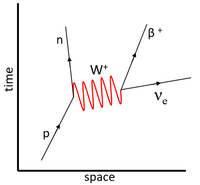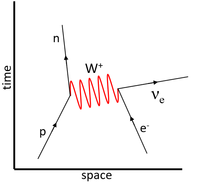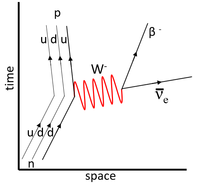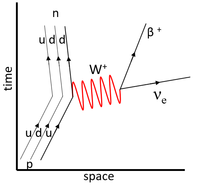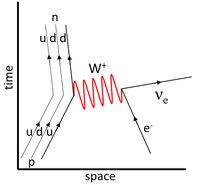Difference between revisions of "Weak Nuclear Interaction"
| Line 9: | Line 9: | ||
: The '''weak nuclear interaction''' is mediated by the [[W-boson]] and [[Z-boson]]. | : The '''weak nuclear interaction''' is mediated by the [[W-boson]] and [[Z-boson]]. | ||
: The effective range of the '''weak nuclear interaction''' is smaller than the [[diameter]] of a [[proton]]. | : The effective range of the '''weak nuclear interaction''' is smaller than the [[diameter]] of a [[proton]]. | ||
| + | |||
| + | ===Examples=== | ||
| + | {| class="wikitable" | ||
| + | |+W-boson interactions for [[nucleon]]s. | ||
| + | |[[File:FeynmanDiagramNeutronDecay.png|center|200px]] | ||
| + | |[[File:FeynmanDiagramPositronEmission.png|center|200px]] | ||
| + | |[[File:FeynmanDiagramElectronCapture.png|center|200px]] | ||
| + | |- | ||
| + | | style="height:20px; width:200px; text-align:center;" |This [[Feynman Diagram]] shows the [[Weak Nuclear Interaction|weak interaction]] in which a [[neutron]] [[Radioactive Decay|decays]] into a [[proton]]. | ||
| + | | style="height:20px; width:200px; text-align:center;" |This [[Feynman Diagram]] shows the [[Weak Nuclear Interaction|weak interaction]] in which a [[proton]] [[Radioactive Decay|decays]] into a [[neutron]] via [[Positron Emission|positron emission]]. | ||
| + | | style="height:20px; width:200px; text-align:center;" |This [[Feynman Diagram]] shows the [[Weak Nuclear Interaction|weak interaction]] in which a [[proton]] [[Electron Capture|captures]] an [[electron]] to become a [[neutron]]. | ||
| + | |} | ||
| + | |||
| + | {| class="wikitable" | ||
| + | |+W-boson interactions for [[quark]]s | ||
| + | |[[File:FeynmanDiagramDownDecay.png|center|200px]] | ||
| + | |[[File:FeynmanDiagramUpDecay.png|center|200px]] | ||
| + | |[[File:FeynmanDiagramQuarkElectronCapture.png|center|200px]] | ||
| + | |- | ||
| + | | style="height:20px; width:200px; text-align:center;" |This [[Feynman Diagram]] shows the [[Weak Nuclear Interaction|weak interaction]] in which a [[down-quark]] [[Radioactive Decay|decays]] into an [[up-quark]]. This appears as a [[neutron]] becoming a [[proton]], [[electron]] and an [[antielectron-neutrino]]. | ||
| + | | style="height:20px; width:200px; text-align:center;" |This [[Feynman Diagram]] shows the [[Weak Nuclear Interaction|weak interaction]] in which an [[up-quark]] [[Radioactive Decay|decays]] into a [[down-quark]] via [[Positron Emission|positron emission]]. This appears as a [[proton]] becoming a [[neutron]], [[positron]] and [[electron-neutrino]]. | ||
| + | | style="height:20px; width:200px; text-align:center;" |This [[Feynman Diagram]] shows the [[Weak Nuclear Interaction|weak interaction]] in which an [[up-quark]] [[Electron Capture|captures]] an [[electron]] to become a [[neutron]]. This appears as a [[Ground State|ground state]] [[electron]] becoming an [[electron-neutrino]] while a [[proton]] becomes a [[neutron]]. | ||
| + | |} | ||
Latest revision as of 10:05, 1 August 2019
Key Stage 5
Meaning
The weak nuclear interaction is the mechanism governing how hadrons and leptons affect one another.
About The Weak Nuclear Interaction
- The weak nuclear interaction is one of the 4 fundamental interactions governing how subatomic particless affect one another.
- The weak nuclear interaction causes the decay of particles into other, more stable, subatomic particless.
- The weak nuclear interaction can allow neutrons to decay into protons.
- The weak nuclear interaction is mediated by the W-boson and Z-boson.
- The effective range of the weak nuclear interaction is smaller than the diameter of a proton.
Examples
| This Feynman Diagram shows the weak interaction in which a neutron decays into a proton. | This Feynman Diagram shows the weak interaction in which a proton decays into a neutron via positron emission. | This Feynman Diagram shows the weak interaction in which a proton captures an electron to become a neutron. |
| This Feynman Diagram shows the weak interaction in which a down-quark decays into an up-quark. This appears as a neutron becoming a proton, electron and an antielectron-neutrino. | This Feynman Diagram shows the weak interaction in which an up-quark decays into a down-quark via positron emission. This appears as a proton becoming a neutron, positron and electron-neutrino. | This Feynman Diagram shows the weak interaction in which an up-quark captures an electron to become a neutron. This appears as a ground state electron becoming an electron-neutrino while a proton becomes a neutron. |

